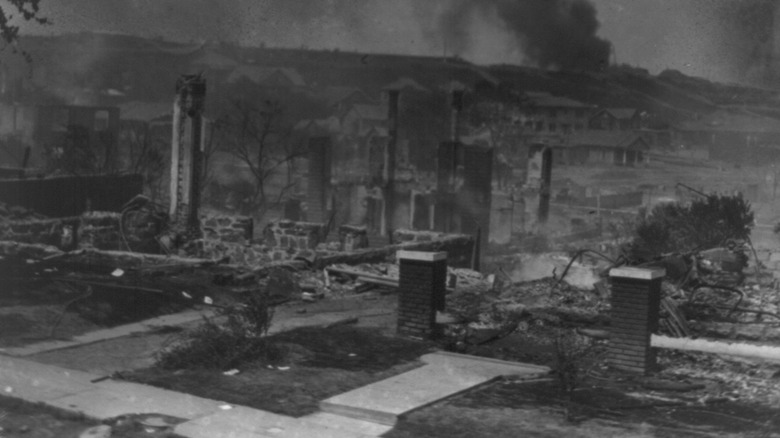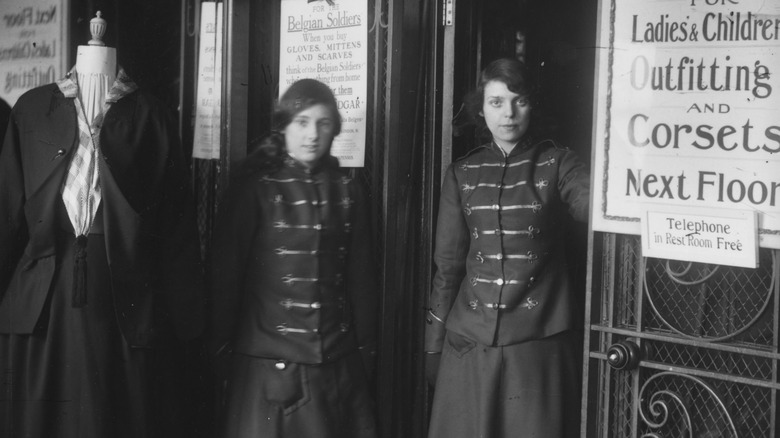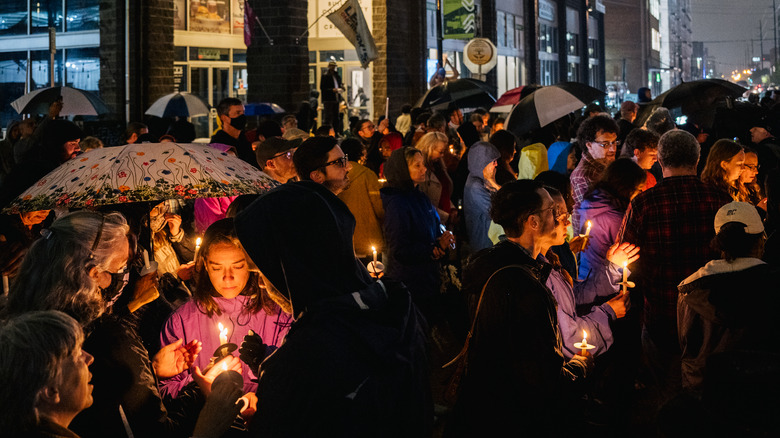What Really Sparked The Tulsa Race Massacre?
The Tulsa Race Massacre, a series of racially-motivated riots in 1921 that left somewhere between 75-300 people dead, and thousands of Black-owned homes and businesses destroyed, became a national topic of conversation in the spring of 2021. That was due in part to its 100th anniversary, but also largely due to the fact that in years past, a concerted effort was made to completely erase it from history. As George Santayana famously said, "those who cannot remember the past are condemned to repeat it" (via Virginia Tech).
The violence, like other historical events, wasn't the result of any one thing; a handful of larger issues set the stage. White Supremacy, Jim Crow laws, and a host of related issues hovered over the Oklahoma city in those years. But, in much the same way that a fire needs a spark to fully get going, the Tulsa Race Massacre can be tied to a single "spark," so to speak. According to the Oklahoma Commission to Study the Tulsa Race Riot of 1921, an accusation was made that a Black teenage boy had committed a crime against a white teenage girl.
The riot started when a Black teenager was accused of raping a White teenager
Dick Rowland, a 19-year-old Black man, was working as a shoe shiner in May of 1921, according to the report by the Oklahoma Commission to Study the Tulsa Race Riot of 1921. On the day of the alleged crime that ignited the riots, he had to use the restroom, and due to the laws at the time, the nearest one that he could legally use was at the top of a nearby building.
Meanwhile, the job of elevator operator that day was being handled by a 17-year-old White girl named Sarah Page. Rowland got into the elevator with Page, not knowing that it would be the last elevator ride he would ever take.
What happened next remains in dispute, but when the elevator arrived at its destination, a witness reported having heard a scream, and Page appeared "disheveled." That was enough to form the accusation that Rowland had raped Page.
Soon enough, Rowland was in jail, according to the book "Riot and Remembrance: The Tulsa Race War and Its Legacy," but that wasn't enough for the White citizens of the city, who wanted to lynch Rowland immediately. Coverage by the city's afternoon newspaper, The Tulsa Tribune, contributed to that fervor to lynch Rowland.
Did Dick Rowland really rape Sarah Page?
Regardless, a mob of armed Whites showed up at the courthouse to demand results, while neighboring Blacks were also preparing for violence. Soon enough, the situation descended into anarchy.
Whether or not Dick Rowland actually raped, or attempted to rape, Sarah Page remains in dispute a century after the incident. The two teenagers almost certainly knew each other before the incident, as their jobs would have had them cross paths multiple times, according to the Oklahoma Commission to Study the Tulsa Race Riot of 1921. They may have been friends or even lovers, a relationship that would have been socially taboo for her, and potentially been deadly for Rowland if it had been found out.
Several things could have happened in the elevator that day, including an actual rape or attempted rape, or consensual contact, or a lovers' quarrel, or a whole lot of nothing. Page said as much to the police, according to the Tulsa World, saying that Rowland had merely grabbed her arm, possibly because he'd tripped, and startled, she cried out. She declined to press charges against her alleged assailant.


